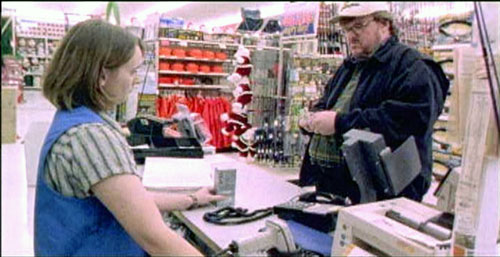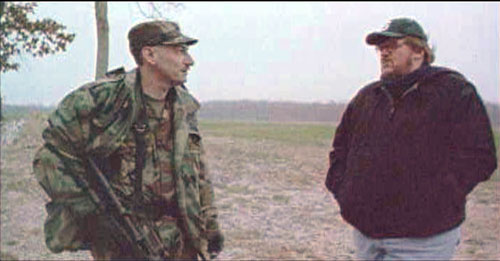Bowling for Columbine


There are too many guns in the United States, and there is something about the culture here that makes people want to use them. Or so filmmaker Michael Moore (And Justice For All, The Big One) thinks. Moore is a vocal liberal documentarian, infamous for his near-theatrical antics made while getting his point across. There are two ways to look at Bowling for Columbine. It is a great piece of entertainment, and only a mediocre serious examination of a real issue. The points that Moore presents are compelling. In one year, there were over 11,000 gun deaths in the United States, far more than any other civilized nation in the world. Canada, Great Britain, Australia, France, and German all have profoundly lower numbers, usually numbering in the low hundreds.
In going about proving his point, Moore develops a scattershot approach at looking for causality. It eventually boils down to a culture of fear, perpetuated by the media and government. Stations televise each bit of news of murder and mayhem because it delivers ratings. It's a long trip to get here, and because of the way that Moore works, it's never that convincing. Instead of presenting a well-developed set of arguments, Moore opts to himself pander to his audience and go for what is most entertaining. In effect, he is creating his own brand of fear. Why interview experts when ambushing Dick Clark or interviewing random dumb people is so much more fun? Granted it makes for great cinema, but feels like tabloid journalism.
There are parts of the movie that work. He makes a stop at a bank where they offer a free gun to anybody who opens an account. By interviewing some of the intellectually questionable people he meets, he is able to show that yes, some of the reasons surrounding gun ownership are ridiculous. He also has a humorous animated short on the history of guns and the United States. Moore is a lifelong member of the NRA, and his interview with Charlton Heston is memorable. Heston visited Columbine a week after the shootings and professed his love for guns. Moore wanted to know if Heston thought it insensitive act giving a grieving community.
However, there are other parts of the film that show just how much of a media whore Moore can become. The aforementioned Clark interview feels pointless. Clark of course refuses to talk, but he really should have no reason to comment. The most potent example of Moore at his best (worst) is when he brings two Columbine survivors with bullets still in their bodies to the Kmart corporate headquarters, asking for refunds on the bullets (they were bought at Kmart). He is extremely effective in using the media to get his point across, to the point of shaming this large corporation into submission. Yes, Moore is good at what he does, but at times there is little to separate the media he demonizes with the way he portrays his ideas.